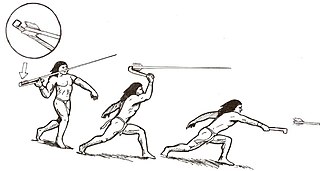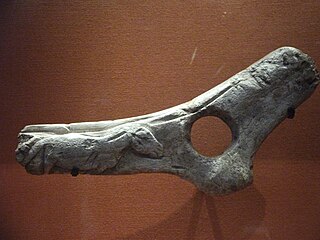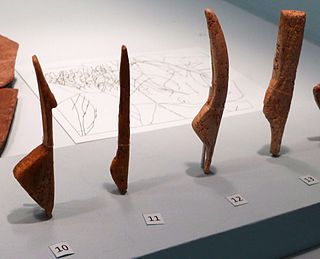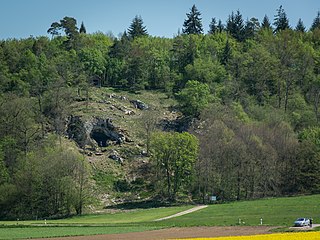
A spear-thrower, spear-throwing lever, or atlatl is a tool that uses leverage to achieve greater velocity in dart or javelin-throwing, and includes a bearing surface that allows the user to store energy during the throw.

The Magdalenian cultures are later cultures of the Upper Paleolithic and Mesolithic in western Europe. They date from around 17,000 to 12,000 years ago. It is named after the type site of La Madeleine, a rock shelter located in the Vézère valley, commune of Tursac, in France's Dordogne department.

In archaeology, a perforated baton, bâton de commandement or bâton percé is a type of artefact from prehistoric Europe made from antler, which probably served many functions such as being used as a spear-thrower, in rope-making, and ceremonial and other uses.

Bison Licking Insect Bite is a prehistoric carving from the Upper Paleolithic, found at Abri de la Madeleine near Tursac in Dordogne, France, the type-site of the Magdalenian culture, which produced many fine small carvings in antler or bone.

The Venus of Hohle Fels is an Upper Paleolithic Venus figurine made of mammoth ivory that was unearthed in 2008 in Hohle Fels, a cave near Schelklingen, Germany, part of the Caves and Ice Age Art in the Swabian Jura UNESCO World Heritage Site. It is dated to between 42,000 and 40,000 years ago, belonging to the early Aurignacian, at the very beginning of the Upper Paleolithic, which is associated with the earliest presence of Cro-Magnons in Europe.

The Hohle Fels is a cave in the Swabian Jura of Germany that has yielded a number of important archaeological finds dating from the Upper Paleolithic. Artifacts found in the cave represent some of the earliest examples of prehistoric art and musical instruments ever discovered. The cave is just outside the town of Schelklingen in the state of Baden-Württemberg, near Ulm. Because of the outstanding archeological finds and their cultural significance, in 2017 the site became part of the UNESCO World Heritage Site Caves and Ice Age Art in the Swabian Jura.

The art of the Upper Paleolithic represents the oldest form of prehistoric art. Figurative art is present in Europe and Southeast Asia, beginning between about 40,000 to 35,000 years ago. Non-figurative cave paintings, consisting of hand stencils and simple geometric shapes, are somewhat older, at least 40,000 years old, and possibly as old as 64,000 years. This latter estimate is due to a controversial 2018 study based on uranium-thorium dating, which would imply Neanderthal authorship and qualify as art of the Middle Paleolithic.

The Swimming Reindeer is a 13,000-year-old Magdalenian sculpture of two swimming reindeer conserved in the British Museum. The sculpture was made in what is now modern-day France by an unknown sculptor who carved the artwork from the tip of a mammoth tusk. The sculpture was found in two pieces in 1866, but it was not until 1904 that Abbé Henri Breuil realised that the two pieces fit together to form a single artwork of two reindeer swimming nose-to-tail.

The Wolverine pendant of Les Eyzies is a bone pendant decorated with an engraved drawing of a wolverine, probably from the cave of Les Eyzies, Dordogne, France. The pendant is from the late Magdalenian period and around 12,500 years old. It now forms part of the Christy Collection in the British Museum, where it is normally on display in Room 2. Between 7 February - 26 May 2013 it was displayed in the exhibition at the British Museum Ice Age Art: Arrival of the Modern Mind

The Robin Hood Cave Horse is a fragment of rib engraved with a horse's head, discovered in 1876, in the Robin Hood Cave in Creswell Crags, Derbyshire. It is the only piece of Upper Paleolithic portable art showing an animal to have been found in Britain. It is now in the British Museum, but normally not on display. Between 7 February and 26 May 2013 it was displayed in the exhibition at the British Museum Ice Age Art: Arrival of the Modern Mind. A replica of the artifact is displayed at the Creswell Crags Museum.
Alfred Rust was a German prehistoric archaeologist. Though self-taught, he became a pioneer in the study of the Hamburgian culture of the late Paleolithic, especially through his excavations in northern Germany.

The Venus figurines from Gönnersdorf, at Neuwied, are paleolithic sculptures depicting the female body.

The Pinhole Cave Man or Pin Hole Cave Man is the common name for an engraving of a human figure on a woolly rhinoceros rib bone dating to the Upper Paleolithic that is now in the British Museum. In the 1920s, a woolly rhinoceros rib that was broken at both ends was found in Pin Hole Cave, Creswell Crags, Derbyshire, England.

An example of the art of the Upper Paleolithic in the Last Glacial Period, this decorated fragment of a perforated antler baton was discovered in 1863 by Edouard Lartet and Henry Christy at the Abri de la Madeleine, an overhanging cliff situated near Tursac, in the Dordogne département and the Aquitaine Région of South-Western France. This is the type-site for the Magdalenian culture, currently dated to around 17,000 to 12,000 years ago. It was bequeathed to the British Museum by Christy, and is now catalogued as Palart 310, but not normally on display.

The Montastruc decorated stone is an example of Ice Age art, now in the British Museum. A human figure that appears to be female has been scratched or engraved to decorate a fragment of limestone used as a lamp. The piece was excavated from Courbet Cave, Penne, Tarn, Midi-Pyrénées, France, on the northern bank of the river Aveyron, a tributary of the Tarn. It is dated to around 11,000 BCE, locally the Late Magdalenian culture during the Upper Palaeolithic, towards the end of the last Ice Age. It was excavated by Edouard Lartet and Henry Christy in 1863, and among other items bequeathed to Christie's museum.

The Venus of Petřkovice is a pre-historic Venus figurine, a mineral statuette of a nude female figure, dated to about 23,000 BCE in what is today the Czech Republic.

The Vogelherd Cave is located in the eastern Swabian Jura, south-western Germany. This limestone karst cave came to scientific and public attention after the 1931 discovery of the Upper Palaeolithic Vogelherd figurines, attributed to paleo-humans of the Aurignacian culture. These miniature sculptures made of mammoth ivory rank among the oldest uncontested works of art of mankind. Because of the cultural importance of these sculptures and the cave's testimony to the development of Paleolithic art and culture, in 2017 the site became part of the UNESCO World Heritage Site called Caves and Ice Age Art in the Swabian Jura.

The Brillenhöhle is a cave ruin, located 16 km (9.94 mi) west of Ulm on the Swabian Alb in south-western Germany, where archaeological excavations have documented human habitation since as early as 30,000 years ago. Excavated by Gustav Riek from 1955 to 1963, the cave's Upper Paleolithic layers contain a sequence of Aurignacian, Gravettian and Magdalenian artifacts. In 1956 the first human fossils were discovered within a fireplace in the center of the cave, a discovery which made important contributions to the foundational understanding of the Magdalenian culture of central Europe.

The Bockstein Cave, German: Bocksteinhöhle is part of the Bockstein complex – a White Jurassic limestone rock massif. The 15 by 20 m rock shelter, among small peripheral caves is situated around 12 m (39 ft) above the Lone River valley bottom, north of the towns of Rammingen and Öllingen, Heidenheim district in the central Swabian Jura, southern Germany. Several small openings, that are the actual entrances to the site, lead to various cave sections. The large frontal opening is of modern origin, created during the first excavation works in the late 19th century.

















